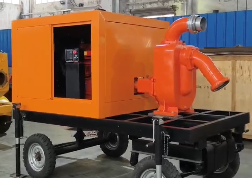Design and optimization of high-efficiency drainage pump
The design and optimization of efficient drainage pumps is a comprehensive process aimed at improving the drainage efficiency, reliability and economy of the pump station. The following is an overview of several key aspects of the design and optimization of efficient drainage pumps:
1. Determine the reasonable scale and site selection
Scale determination: Accurately calculate the scale of the pump station based on factors such as rainwater flow, topography, and drainage requirements to ensure that the pump station is neither too large to waste resources nor too small to meet drainage needs.
Reasonable site selection: Prioritize the construction of pump stations in areas with low terrain and prone to water accumulation so that accumulated water can be collected and discharged more effectively.

2. Pump selection and configuration
Efficient water pumps: Select high-efficiency and low-energy water pumps to ensure normal operation during maximum rainfall. Consider parameters such as water pump flow, head, power, efficiency, as well as factors such as operating stability, reliability and life.
Optimized configuration: Reasonably configure water pump units of different specifications according to actual needs to achieve parallel or series operation of water pumps and improve overall drainage capacity.
3. Structural design and optimization
Modular design: Modular design is adopted to facilitate the assembly, disassembly and maintenance of the pump station. Optimize the internal layout of the pump station and improve space utilization.
Water flow optimization: Design a reasonable structure of the water inlet pool, pump room and outlet pool to ensure smooth water flow and reduce hydraulic loss.
4. Electrical and control system
Electrical safety: Select high-quality electrical components to ensure the stability and reliability of the electrical system. Reasonably arrange wires and cables to reduce the occurrence of electrical accidents.
Intelligent control: Use advanced PLC control systems or intelligent control systems to achieve remote monitoring and automatic control of pump station equipment. Through data analysis and prediction technology, potential problems can be discovered in advance to improve the operating efficiency and safety of the pump station.
5. Energy saving, environmental protection and safety protection
Energy-saving design: Use frequency conversion technology, reactive power compensation and other technologies to reduce energy consumption and improve the economy of the pump station. At the same time, adopt low-noise and low-energy consumption designs to reduce the impact on the environment.
Safety protection: Set up safety protection facilities such as lightning protection and flood control to ensure the safety of staff and equipment.
6. Maintenance and management
Regular maintenance: Establish a complete maintenance management system, regularly inspect and maintain pump station equipment, and ensure the normal operation and service life of the equipment.
Emergency Plan: Develop emergency plans to deal with unexpected situations, such as extreme weather and equipment failure, to ensure that the pump station can respond promptly and drain water effectively.




